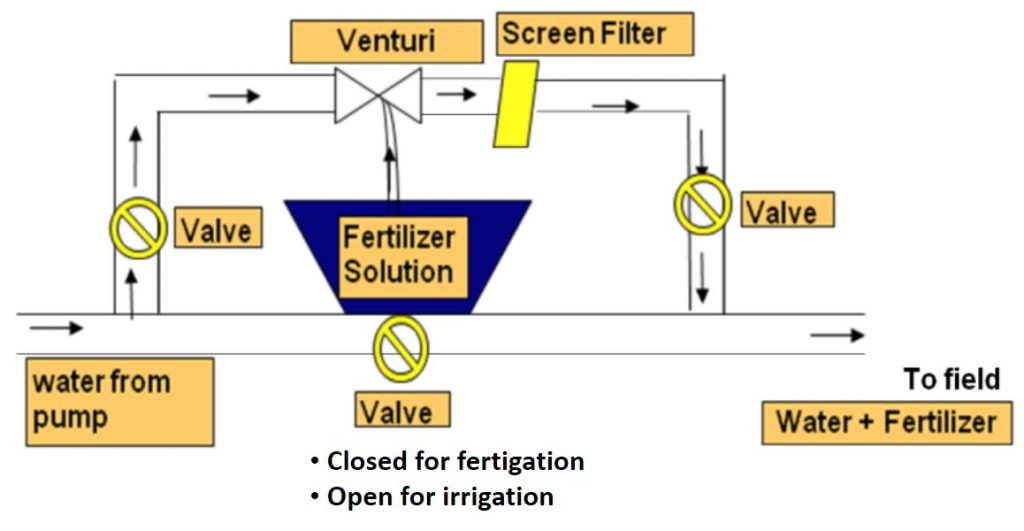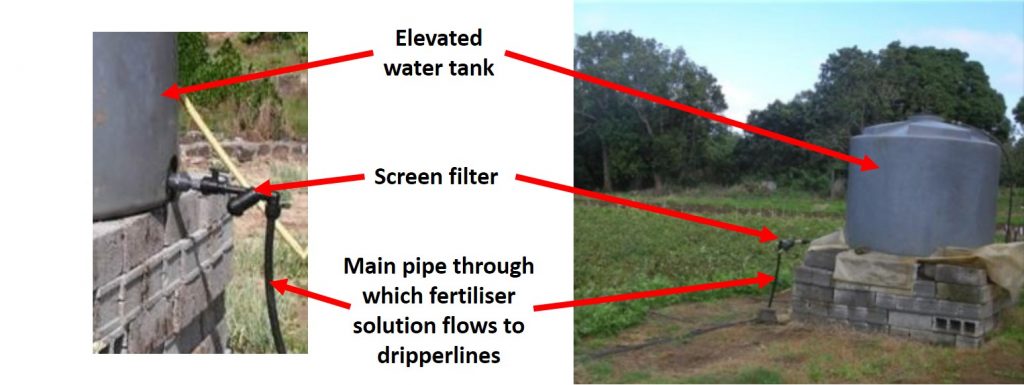Fertigation
Fertigation refers to the application of nutrients to a crop through the system of irrigation. The most common fertigation system is the application of water soluble fertilisers near the roots of plants through drip irrigation. In Mauritius, this system is used in hydroponics, in nurseries, for cultivation under protected structures as well as in the open field. Fertigation allows for the precise and timely feeding of a crop with the correct amount of major and minor nutrients which are required for a healthy and productive growth.
Benefits of fertigation
- Fertigation allows for a better distribution and uniform application of fertilisers as the fertilisers are dissolved in the irrigation water.
- Every single plant in the field receives the amount of nutrients it requires accurately and uptake of nutrients is improved.
- It saves time and labour as the fertilisers are not applied manually.
- It allows for the adjustment of fertiliser requirements at each growth stage.
- Since soluble fertilisers are applied in small quantities at the root zone, there is lower nutrient loss from the soil surface and there is no risk of nutrient leaching to the groundwater.
- Crop yield is generally increased by 40% to 50% and the quality of produce is improved.
Disadvantages of fertigation
- The design, installation and operation of a fertigation system may require the assistance of a professional.
- The cost of a fertigation system is high.
Fertilisers used for fertigation
The commonly used soluble fertilisers in Mauritius are summarised in the table below:
| Crop Growth Stage | Soluble Fertilisers used |
|---|---|
| Vegetative Stage | Urea, Monoammonium phosphate (MAP), Magnesium sulphate |
| Flowering and fruiting stage(example: Tomato) Bulb formation stage(example: Onion) Tuber formation(example: Potato) | Potassium nitrate, Calcium nitrate, Microelements |
Types of fertigation systems using drip irrigation
- Pressurised drip fertigation system using a water pump The components of a pressurised drip irrigation system include:
- a plastic container (for field of 1 arpent, minimum capacity of 50 L) to dissolve fertilisers in water
- a Venturi pump (min. 25 mm [¾”] – max. 50 mm [1½”]) to inject the dissolved fertilisers into the irrigation system
- a water pump to operate the drip irrigation system
- a screen filter to remove impurities from the fertiliser solution to prevent clogging of the drip system
Fertigation headwork with a Venturi pumpSchema flow of a Venturi system

When irrigation water is pumped through the Venturi, fertiliser solution in the container is sucked and flows with the irrigation water.
2. Gravity-fed drip fertigation
The gravity-fed drip fertigation system requires no pump. It is easy to install, operate and maintain. It is a low pressure drip system suitable for small plots of up to 1250 m2 with flat topography. The water tank is fixed at a height of 1.0 to 1.5 m on concrete blocks. Soluble fertilisers are dissolved in the irrigation water in the tank. The solution flows by gravity to the dripper lines.


Timing of fertigation
Fertigation is carried out 3 times per week on every alternate day (e.g. Monday, Wednesday and Friday). To prevent clogging of the drip fertigation system, it is recommended to allow 2 minutes irrigation after fertigation. Fertigation should not be carried out during rainy days to minimise leaching below the root zone.
Maintenance of fertigation systems
- Daily inspection and cleaning of screen filter to prevent clogging
- Flushing of the drip fertigation system for 2 minutes
- Every week if water used is from canals or streams
- Every month if potable water is used
- Flushing with phosphoric acid or sodium hypochlorite in case of severe clogging. Contact your Extension Officer for advice.
- Cleaning of the water tank after each crop cycle for the gravity-fed drip fertigation
Useful tips for fertigation
- Avoid using transparent or translucent drums to prevent algal growth
If water is muddy, pre-filter or allow to settle before adding to the tank
Crop yield under fertigation
Studies carried out under local conditions using recommended fertiliser rates have shown that fertigation significantly improves crop yield and quality.
Crop | Yield (t/arp) | % Increase in crop yield with fertigation | |
Manual application of mineral fertilisers | Fertigation | ||
Carrot var Kuroda | 8.74 | 11.73 | 34 |
Potato var. Spunta | 11.76 | 19.15 | 63 |
Potato var. Delaware | 12.89 | 20.58 | 60 |

